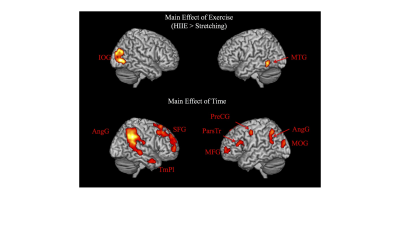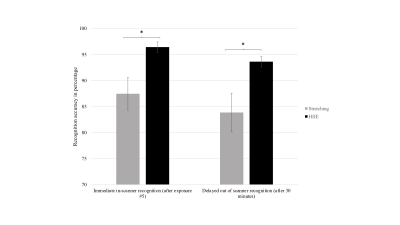1447
Neural correlates of associative new word learning enhancement following high-intensity interval exercise in healthy older adults.1The University of Queensland School of Health and Rehabilitation Sciences, Brisbane, Australia, 2University of Queensland Centre for Clinical Research, Brisbane, Australia, 3The University of Queensland School of Human Movement and Nutrition Sciences, Brisbane, Australia, 4Centre for Visual and Neurocognitive Rehabilitation, Atlanta, GA, United States, 5University of Pittsburgh, Pittsburgh, PA, United States, 6Queensland University of Technology School of Clinical Sciences, Brisbane, Australia
Synopsis
High-intensity interval exercise (HIIE) can benefit word learning in young adults, however this is yet to be investigated in older adults and the neural mechanisms responsible have not been directly examined. Twenty-six older adults participated in this study and engaged in stretching or HIIE prior to performing an in-scanner (fMRI) associative new word learning task. Results showed increased activation after HIIE, in the left middle temporal gyrus, and right inferior occipital gyrus in addition to better word recognition accuracy, suggesting benefits of HIIE on word learning that may be attributed to increased activation in key language and visual processing areas.
Introduction
With increasing age, older adults often experience normal cognitive decline including a reduced ability to learn new words.1,2 With population ageing being a worldwide challenge, there is a need to identify new approaches to delay age-related cognitive decline and promote new word learning in older adults. High-intensity interval exercise (HIIE) has been associated with new word learning success in young adults.3 However, it remains unclear whether HIIE could also benefit new word learning performance in older adults, and the neural mechanisms responsible are yet to be investigated. Thus, the aim of this study was to examine the effects of HIIE in comparison to stretching (i.e., attention control condition) on immediate and delayed new word recognition accuracy and related brain activation patterns during learning and recognition, using functional Magnetic Resonance Imaging (fMRI).Methods
Twenty-six healthy older adults (mean age= 66.4 ± 4.8; 12 females) participated in this randomised controlled trial and attended two testing sessions. In the first session, participants completed a cognitive assessment and a cardiopulmonary exercise test to determine peak heart rate (HRpeak). In the second session (i.e., 2 weeks later), half of the participants (n=13; 5 females) performed 33 minutes of gentle upper and lower stretching exercises. The remaining participants engaged in HIIE on a cycle ergometer, and performed a 5-minute warm-up, followed by 4x4 minutes at 85-95% of HRpeak interspersed by 3x3 minutes at 50-65% of HRpeak and a 3-minute cool-down. Within 15 minutes of stretching or HIIE, participants completed an in-scanner (fMRI) associative new word learning task, which consisted of 2 blocks of 15 familiar objects paired with nonwords. Within the two blocks, each individual object-nonword pairing was presented five times and learning success of the nonwords was assessed after the second and fifth exposure using a recognition task where three possible nonwords were presented. Participants were instructed to accurately select the correct new name for each object. Delayed recognition of the nonwords was also assessed 30 minutes later. Raw imaging data was processed in SPM12 (Wellcome Trust Centre for Neuroimaging, 2014), and submitted to an exploratory whole brain analysis. A 2 x 5 factorial design was developed to model exercise (i.e., stretching and HIIE) by object-nonword exposure (1- 5), in addition to several two-sample t-tests examining group differences in BOLD signal. Welch’s ANOVAs were conducted to investigate between group differences in immediate and delayed recognition accuracy.Results
Results are reported for height threshold of p<.001 uncorrected and clusters corrected at the voxel level for family wise error (FWE; p<.05). A main effect of exercise was detected in the right inferior occipital gyrus (PFWE <.001, x=45, y=-78, z=2, Z=4.87) and in the left middle temporal gyrus (PFWE=.005, x=-56, y=-56, z=6, Z=4.27) (see Figure 1). This effect was characterized by a significantly increased BOLD signal in these regions following HIIE relative to stretching, when collapsed across learning exposures. For both HIIE and stretching, a main effect of time was observed in eight brain regions, notably the left pars triangularis (p=.004), left middle frontal gyrus (MFG; p<.001), and left precuneus (p<.001), as well as the bilateral angular gyrus (p<.001). BOLD signal was generally observed to increase in these regions across learning exposures 1 to 5 (see Figure 1). No significant between group differences in BOLD signal were found during the in-scanner immediate recognition task (p>.05). Behaviourally, between-group differences were found in new word recognition accuracy tested after the fifth exposure, with the HIIE group recognising significantly more new words than the stretching group (p=.017) (see Figure 2). Between-group differences were also observed when assessing delayed recognition accuracy 30 minutes later, with the HIIE group recognising significantly more new words than the stretching group (p=.027) (see Figure 2).Discussion
Whole brain analysis revealed that in healthy older adults, a single bout of HIIE performed immediately prior to an associative word learning task was associated with increased recruitment of key language and visual processing areas during learning, when compared to stretching. Furthermore, HIIE, relative to stretching, was associated with increased accuracy in both the immediate and delayed recognition of newly learned words. These behavioural results are consistent with findings in healthy young adults, which have also previously suggested immediate and delayed effects of high-intensity exercise on new word learning performance.3 The responsiveness of the left middle temporal gyrus to a single bout of exercise suggests greater involvement of regions associated with lexical-semantic processing in the context of post-HIIE new word learning,4 whereas the strong right inferior occipital gyrus BOLD activation during new word learning following HIIE may reflect greater exercise-induced recruitment of visual processing areas to support the integration of visual information, reflecting the nature of the learning task.5Conclusion
This study is the first to investigate the effects of HIIE on new word learning performance using fMRI to explore underlying neural mechanisms in healthy older adults. Exercise-induced behavioural results may be related to changes in language and visual related brain activation patterns elicited by HIIE. Further studies with larger samples are needed to confirm the effect of HIIE on associative new word learning and its brain activation patterns in healthy older adults.Acknowledgements
The authors would like to thank all participants for their time and involvement in this study.References
1. Whiting E, Chenery HJ, Copland DA. Effect of aging on learning new names and descriptions for objects. Neuropsychol Dev Cogn B Aging Neuropsychol Cogn. 2011;18(5):594-619.
2. Service E, Craik FIM. Differences Between Young and Older Adults in Learning A Foreign Vocabulary. J Mem Lang. 1993;32(5):608-623.
3. Winter B, Breitenstein C, Mooren FC, et al. High impact running improves learning. Neurobiol Learn Mem. 2007;87(4):597-609.
4. Mei L, Chen C, Xue G, et al. Neural predictors of auditory word learning. Neuroreport. 2008;19(2):215-219.
5. Marcotte K, Ansaldo AI. Age-related behavioural and neurofunctional patterns of second language word learning: Different ways of being successful. Brain Lang. 2014;135:9-19.
Figures

